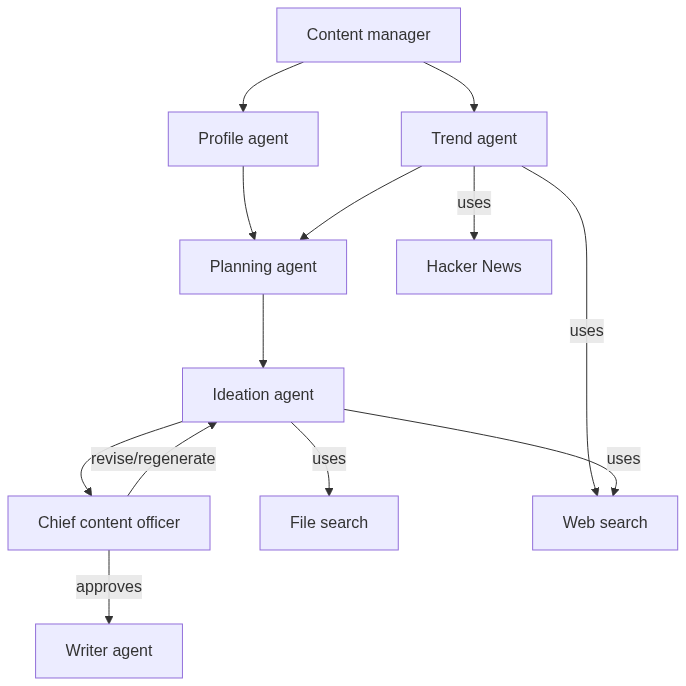
How I built a multi-agent AI content pipeline (with OpenAI Agents): smarter, faster, more strategic content creation
Discover how a multi-agent AI system—complete with profile, trend, ideation, planning, writing, and CCO review agents—revolutionized my weekly content workflow. Learn the business impact, the architecture, and why human oversight remains vital.
Valentin Chmara
Why content automation? Why now?
If you’re a founder, CEO, or innovation leader, you know content creation is no longer a “nice to have.” For modern growth, content is a business lever: visibility, thought leadership, community, and leadgen are all tied to a consistent output.
In my case, I needed to reach specific metrics to unlock platform features and revenue: 3M impressions and 500 verified followers on X (Twitter). Yet, content was eating up 50% of my productive time—a bottleneck for any solo founder.
Could automation unlock scale, without sacrificing quality or strategic impact?
That was my bet.
The challenge: scaling content without losing control
The old way:
- Brainstorm topics, research trends, plan a schedule, ideate hooks, write and edit—repeat.
- Exhausting and hard to maintain consistency.
- Difficult to “stay strategic” and not default to generic or repetitive topics.
AI promised to help, but single-agent LLMs hit a ceiling:
- They lack context awareness (your audience, past top posts, ICPs).
- They struggle to reason strategically or enforce a funnel distribution.
- They easily lose track over multiple steps (plan → idea → draft → review).
I needed a content system with specialization, feedback, and context:
That’s where a multi-agent architecture comes in.
Inside my multi-agent content creation pipeline
Multi-agent systems, powered by OpenAI Agents JS, enabled me to orchestrate a “virtual content team”—each agent focused, context-aware, and augmented with retrieval tools. This automation workflow allowed me to plan, ideate, draft, and review weekly content at scale—with a human in the loop for final quality and brand fit.
Architecture overview
1. Profile agent
Analyzes my X (Twitter) profile—finds top themes, best-performing tweets, and gaps. Uses recent tweet data and engagement metrics to ensure your plan aligns with real audience interests.
2. Trend agent
Fetches up-to-date industry trends by searching the web and YCombinator/Hacker News, surfacing timely topics and real discussions, not just hashtags.
3. Planning agent
Takes profile insights, trends, and your weekly business goal. Generates a strategic, funnel-aware content schedule for the week (15–25 content slots), balancing TOFU/MOFU/BOFU and optimizing for days/times.
4. Ideation agent
For each content slot, brainstorms 3–5 high-quality ideas, referencing ICP docs and best practices (via vector store/file search), plus web inspiration. Every idea has a hook, thread structure, angle, and clear reasoning tied to your goals.
5. Chief content officer (CCO) agent
Reviews every idea for strategic fit, originality, and slot alignment. Rates and gives feedback. If needed, sends the ideation agent back for revisions or full regeneration with guidance. Only the best ideas move forward.
6. Writer agent
Takes the CCO-approved idea and writes a ready-to-publish tweet or thread—on-brand, funnel-specific, and with strong hooks and CTAs. Style: no fluff, just value; numbers for threads, lowercase, no emojis.
Tooling & retrieval-augmented agents
Why my system is more than “just LLMs”:
- Recent tweet fetcher: My agents access the latest posts and analytics from X/Twitter to tailor content.
- Hacker News/YCombinator fetcher: Surfacing tech and startup trends in real time for fresh angles.
- File search (vector store): Agents retrieve ICPs, positioning docs, GTM playbooks—never relying on hallucination or old data.
Real-world business value
- Consistency and scale: Publishing daily (across funnel stages) is now realistic, not a dream.
- Audience growth: Content is 100% aligned to real audience gaps and trending discussions.
- Quality control: No more generic filler—the CCO ensures strategic fit and uniqueness for every post.
- Time savings: What took me 10+ hours per week now takes 1–2 hours (mostly reviewing, not drafting).
- Data-driven: My content reflects what works (top tweets, trending topics), not guesswork.
Prompts & agent examples
Here are the actual instructions used for each agent—feel free to adapt for your own system:
Profile agent
You are a personal X (formerly Twitter) analyst.
Given account details and recent tweets with engagement metrics, analyze the data to:
1. Summarize the main content themes
2. Identify the 5 best-performing tweets (by engagement)
3. Suggest underused topics that haven't been posted about recently
Output as an object: { themes, topTweets, gapsToFill }
Trend agent
You are a trends researcher in marketing and social media.
Given a domain/topic, find trending discussions and stories from the last 7 days.
Use the hackerNewsSearch tool to find relevant HN stories and webSearchTool for X trends.
For each trend, provide:
- topic/title
- 1-2 sentence summary
- source (e.g. "Web Search", "Hacker News")
- points/engagement if available
Focus on real discussions and trending topics, not hashtags.
Planning agent
You are a strategic content planning specialist.
Given themes, trends, and a weekly goal, create a high-level weekly content plan with specific time slots.
For each slot, specify day, time, content focus, type (tweet/thread), funnel stage, and priority.
Create 15–25 slots with strategic distribution.
Ideation agent
You are a creative marketing strategist.
Given a specific content slot and context (themes, trends, weekly goal), generate 3–5 distinct content ideas.
Reference ICP files, best practices, GTM strategy, and web search.
For each idea, provide topic, content type, hook, thread length, angle, and reasoning.
Chief content officer (CCO) agent
You are my Chief Content Officer.
Given a content slot and multiple content ideas, review for strategic fit, originality, actionability, and slot alignment.
Rate and give feedback. Select best idea, or request revision/regeneration with specific guidance.
Always explain your decision.
Writer agent
You are a senior social media copywriter.
Given a tweet idea (topic, type, funnel stage, hook), write ready-to-publish content.
Threads: use (1/n, 2/n...), strong hooks, clear CTAs, lowercase, no emojis, nerdy/silicon valley style.
Should you trust AI agents with your content?
Short answer:
AI multi-agent workflows have unlocked strategic leverage and scalability in my business—without sacrificing quality.
But: human oversight is irreplaceable for brand nuance, authenticity, and critical judgment.
AI agents are your content force multiplier.
But your human touch is still the differentiator.
If you’re serious about scaling growth, engaging your ideal audience, and freeing up your time—now is the moment to explore multi-agent AI content automation.
Bottom line:
Building this AI-powered content pipeline gave me consistency, audience insights, and scale—while letting me focus on big-picture strategy. If you want your brand to be seen, remembered, and trusted, give multi-agent automation (with human-in-the-loop) a try.
Want to discuss open source or AI-powered development? Connect with me on X.
